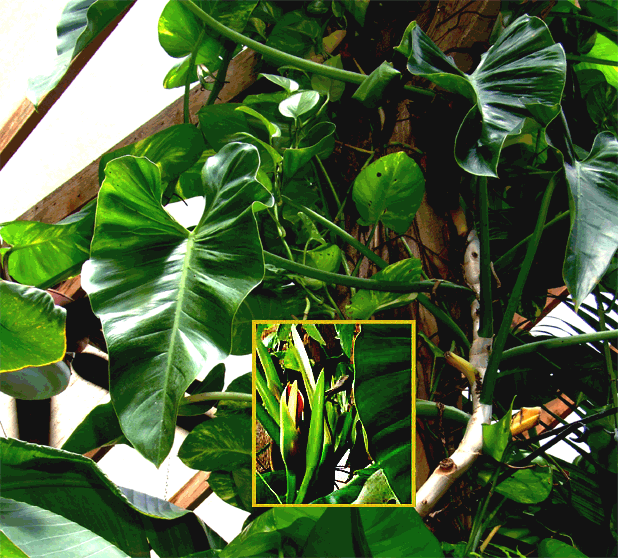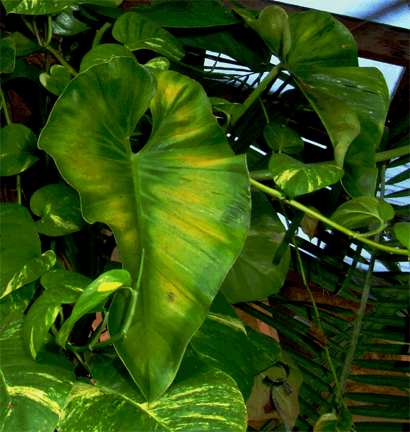![]()
Aroids and other genera in the Collection
Take the Tour Now?
Orchids
The
Exotic Rainforest
Plants in
the Exotic Rainforest Collection
Images on this website are copyright protected. Contact
us before any reuse.
Philodendron sagittifolium
Liebm.

Philodendron sagittifolium
Liebm.
Synonyms:
Philodendron tanyphyllum,
Philodendron
sanguineum,
Philodendron
lancigerum, Philodendron tuxtlanum,
Philodendron lancigerum,
Philodendron daemonum,
Philodendron ghiesbrechtii 
In 1997 a friend brought me a "house plant". It was definitely a Philodendron, but he knew little else about the plant. My friend was a grounds keeper for Metro-Dade County in Miami, FL and had been placed in charge of the abandoned property that was formerly Orchid Jungle Park. Orchid Jungle was at one time a magnificent place to wander through a "rain forest" and see rare and exotic plants as well as hundreds upon hundreds of blooming orchids. The place was so much a jungle it even had monkeys running loose in the trees!
Orchid Jungle was devastated by Hurricane Andrew in 1992 and it's buildings and most of it's plants were literally blown away. This cutting was a survivor of Andrew's wrath. The plant was slow to grow when first planted but soon began to climb a tree on our property in the southern part of Miami. As much as I tried, I could not find out what the proper scientific name was for the species.
When we began to prepare to move to Northwest Arkansas I elected to leave the plant but took another cutting. That cutting was planted on the south side of the center post of our Exotic Rainforest and did it begin to grow! In 3 years it's leaves hit their current maximum size of approximately 70cm (28 inches) and it has shot up the post to a height of 300cm (10 feet). But I still did not know it's name despite having given cuttings to a number of botanist and plant collector friends in an attempt to get a proper ID.
Finally, in the Spring of 2005, I acquired several Philodendron species from Central America, and one soon revealed itself to apparently be this same plant. The grower had identified it as "Philodendron mandaianum". During the summer of 2005 my parent plant finally produced a very short lived inflorescence (bloom), a lovely large spathe with a red center. A photo of that inflorescence along with a photo of the plant was sent back to Central America where it was identified by the grower as "Phildoendron mandaianum". So after 8 years of wondering what this plant that survived the anger of one of the country's worst hurricanes really was, I finally thought I knew what I was growing. But that "discovery" was only to be short lived.
In May of 2006 I began to receive email regarding this plant from a knowledgeable grower in Central Florida. The grower/collector was Russ Hammer. He didn't question my identification but he did bring some news to my attention which made me begin to question that identification. So I finally turned to one of the best botanists in the country, Dr. Tom Croat of the Missouri Botanical Garden, for a clarification. Guess what? The Central American grower had his plant misidentified. Dr. Croat pointed out that "Philodendron mandaianum" was not a published, or recognized scientific name! He called it simply a "made-up" name. That name does appear in some collector's plant texts including Exotica but only as a hybrid Philodendron. The name does not appear on a single scientific database! But Dr. Croat did offer an expert opinion of the actual name of the plant based solely on a photo of the leaf blade: Philodendron smithii, Engler. The problem was, I failed to show Dr. Croat a photo of the spathe and spadix, only the leaf blade. That was a major error on my part.
Once I finally got around to showing Dr. Croat a the photo of the spathe and spadix along with a photo of the leaf blade over one year later, the identification changed. This is the email note I received from Tom,
"I would say that they are both likely to be Philodendron sagittifolium, a widespread and common species." So I pulled out Dr. Croat's Annals of the Missouri Botanical Garden, 1997, Volume 84, #3. In the back of that journal is a black and white photo that is extremely close to matching the photos of my plant's spathe! So I asked again if this was a variable species identified as Philodendron sagittifolium. It is!Philodendron
sagittifolium is found in nature from Mexico to Colombia and is
likely also found in Venezuela. Typically, the species is found near
sea level to elevations as high as 1800 meters (approximately 5500
feet). It is considered the most morphologically variable
and ecologically versatile species in Central America. In most
of Central America it can be found in tropical forests and
pre-mountainous wet rain forests.
Originally described to science in 1849, Philodendron sagittifolium has
been observed to be an extremely variable species. As a result,
it has gained quite a list of synonyms. In botany, a synonym is simply
another name given to the same species but at a later date. Unless a
substantial error can be demonstrated in the original description, the
first name and description become the basionym or base name. All others
become synonyms (Same plant, other name.) The basionym is the
original name applied to the taxon: "basio-" from the Latin: "basis"
from the Greek "bainein", meaning "step", and "-nym" from the Latin
"nomen" meaning "name". It is the first step in the naming process. In
many instances the genus was found to be synonymous but had the
incorrect genus placement.
Philodendron sagittifolium normally grows as a hemiepiphytic Philodendron sp. A hemiepiphyte (hem-a-EPA-fit) is simply a species that can either climb a host tree from the soil or a seed is often placed on a tree branch in the droppings of a bird who has eaten the berry containing the seed. In that case, the specimen will eventually grow long roots extending all the way to the soil. This species is rarely terrestrial . It climbs as an appressed climbing vine pressed close to the host tree. The petioles range from an average of 20 to 65cm (9 inches to 26 niches) in length but have been observed at over 90cm (3 feet) long. The leaf blades are considered to be ovate to triangularly ovate and are semi-glossy and moderately coriaceous. A coriaceous blade is one that is leathery, so these blades would be just less than leathery to the touch.
Philodendron sagittifolium is often very difficult to place a positive identification upon. As is evidenced by all the names botanists have attempted to give the species, it is has many shapes and forms. Many people have difficulty understanding the concept of variableness in plants. The expectation is all leaf blades must look alike. Simply put, think of all your friends. I'd guess you have friends with all sorts of body sizes and shapes. You likely know people with many skin colors as well. But all are a single species, Homo sapiens. Human beings. Plants can often be the same way. Leaves within a species do not always look exactly alike!
Within many species you'll find leaf blades that are "fatter" than others, or "taller" than others, or perhaps, even "shorter" or "skinnier" than others. That is exactly what complicates giving a positive identification to this species. For over a year we thought this specimen was Philodendron smithii. The two species are similar. The major difference is the spathe and spadix the plant can produce. And in our case, once we had a spathe and spadix to examine it eventually became obvious we had the wrong species name on this plant.
The inflorescences of Philodendron sagittifolium are erect and the plant can produce one to three inflorescences per axil. The peduncle, which is the plant structure that supports the spathe, normally measures 4 to 5cm long (1.5 to 2 inches). A peduncle is the internode between the spathe and the last foliage leaf. The spathe is somewhat flattened and green, but is often tinged with red on the inside. The spathe normally measures 8 to 22cm in length. But even the spathe can be somewhat variable. We have observed the spathe to be narrow at the center but that does not always occur as can be seen in the included photo.
Philodendron sagittifolium can produce an inflorescence almost any time of the year, but normally after the beginning of the dry season and continuing throughout most of the rainy season. We typically see the spathe and spadix in our artificial rain forest in May of each year. In nature, there is a slight shift based on geography with "flowering" beginning about one month earlier in Mexico and Guatemala (late winter) but less frequently in September and October. Inflorescence production continues longer in Panama and is seen in February through September and has rarely been observed in December. The fruits take approximately two months to mature. However, in our atrium, we do not have any natural pollinators present to service this species so we have never observed the development of fruit.
Philodendron. sagittifolium is a member of Philodendron section Calostigma subsection Macrobelium ser. Macrobelium. One synonym, Philodendron lancigerum appears to be a narrow leaf form of Philodendron sagittifolium. That form is restricted to the Pacific low lands of Costa Rica.
Want to see the development of the inflorescence
of Philodendron sagittifolium?
Click this link.
In depth information on how to grow Philodendron species, Click this Link
Want to learn more
about aroids?
Join the
International Aroid Society:
http://www.exoticrainforest.com/Join%20IAS.html
 The
finest aroids in Ecuador available direct to any collector!
The
finest aroids in Ecuador available direct to any collector!
http://www.ecuagenera.com//Tropical Plants/Araceae